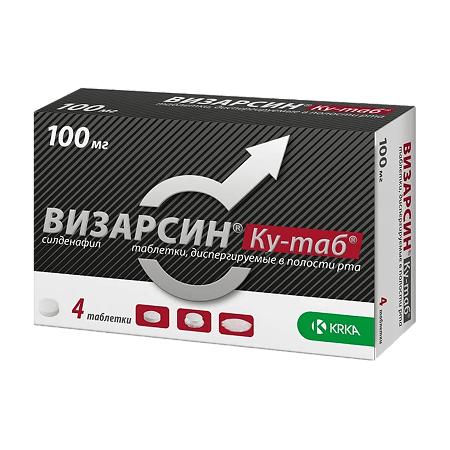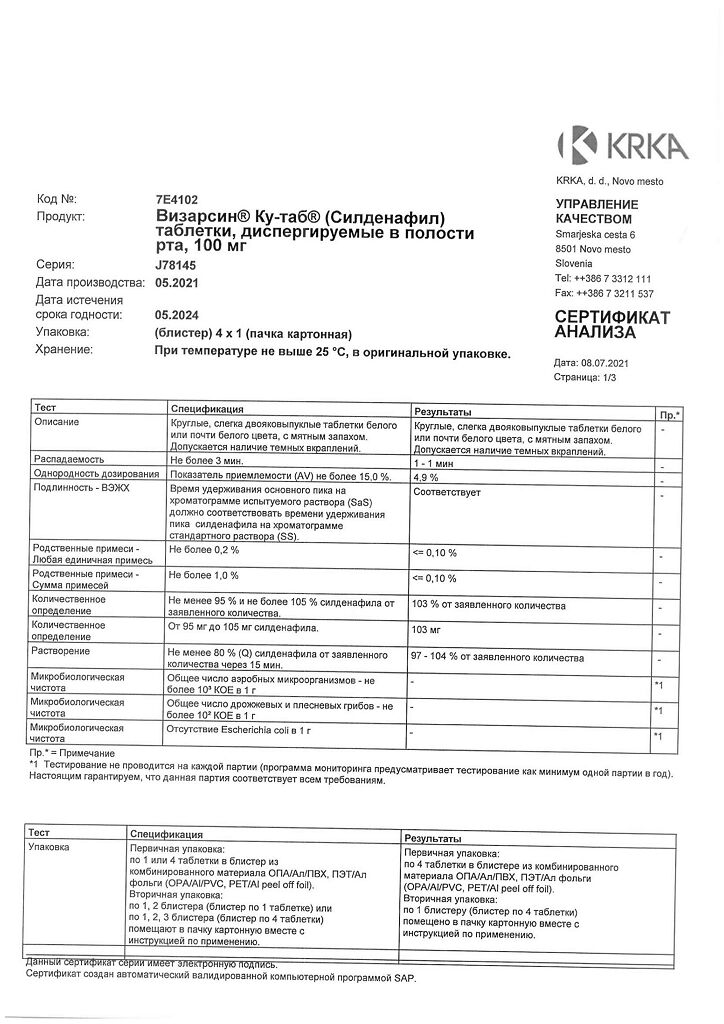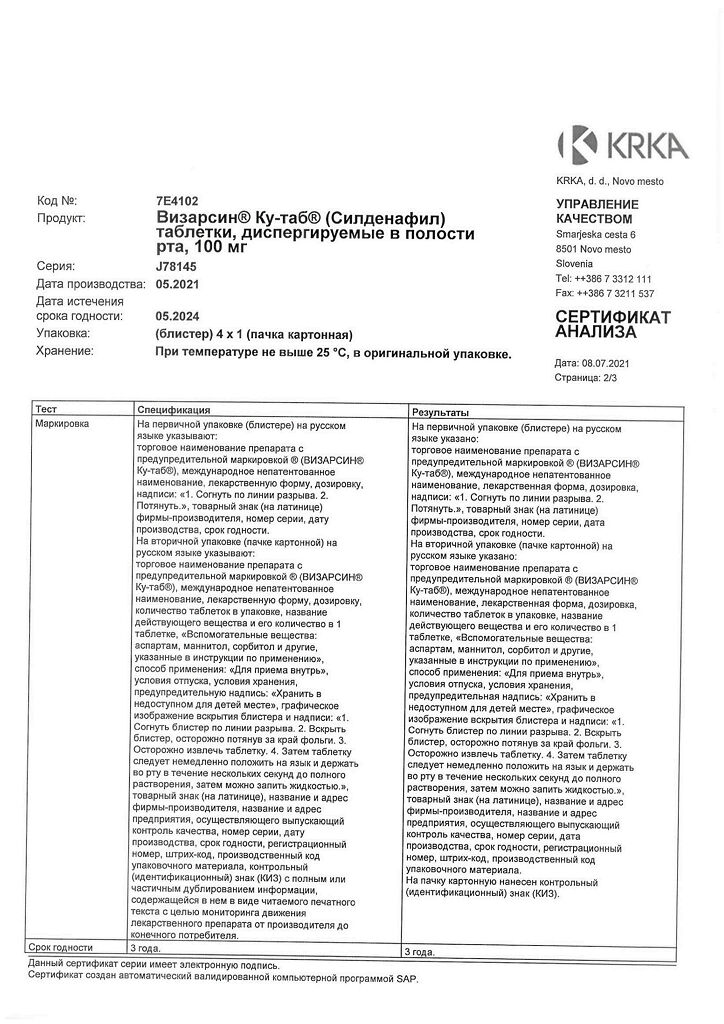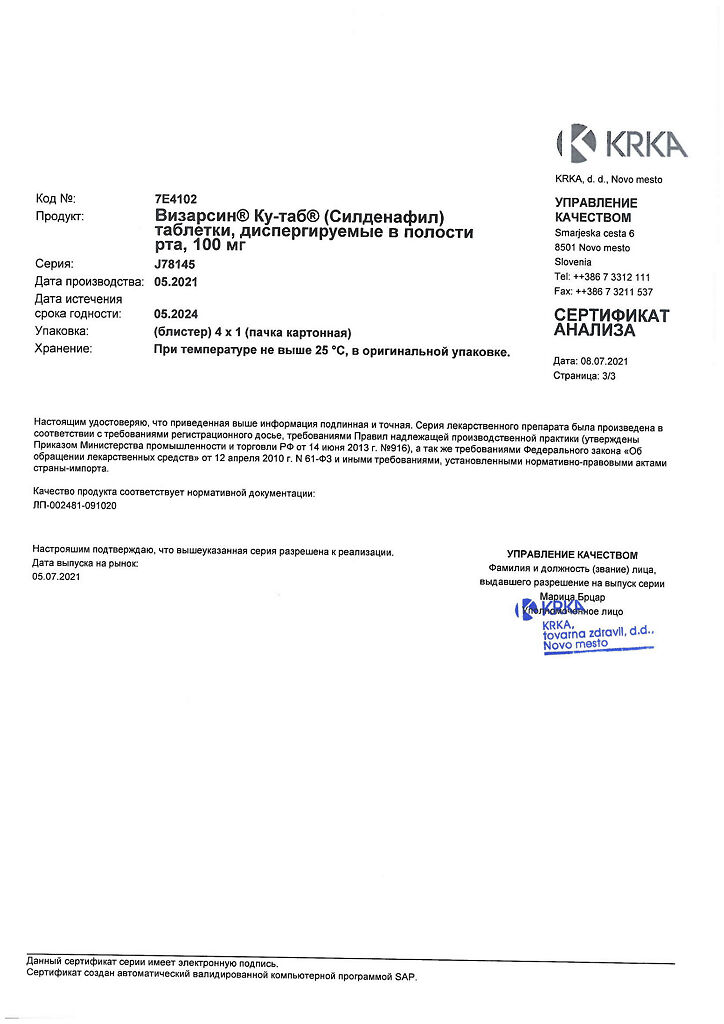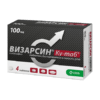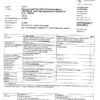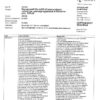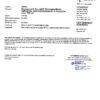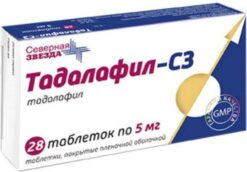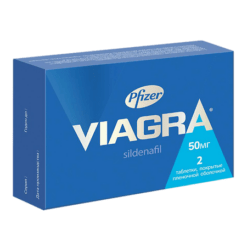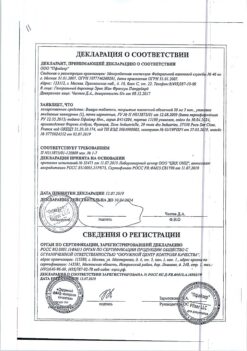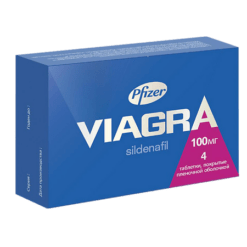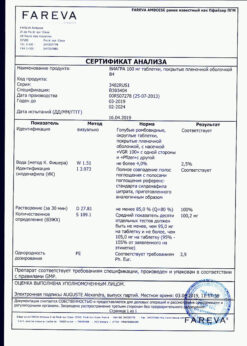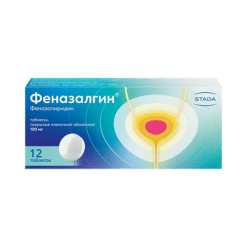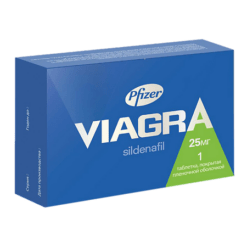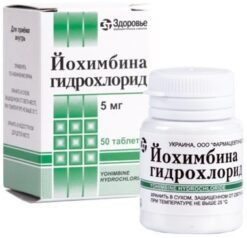No products in the cart.
Visarsin Ku-tab, 100 mg 4 pcs
€32.59 €27.16
Description
Pharmacotherapeutic group: erectile dysfunction treatment – phosphodiesterase type 5 (FDE5)-inhibitor
ATX code: G04BE03
Pharmacological properties
Pharmacodynamics
Sildenafil is a potent selective inhibitor of cyclic guanosine monophosphate (cGMP), a specific FDE5.
Mechanism of action
The realization of the physiological mechanism of erection is associated with the release of nitric oxide (NO) in the cavernous body during sexual stimulation. This, in turn, leads to an increase in the level of cGMP, the subsequent relaxation of the smooth muscle tissue of the cavernous body and an increase in blood flow.
Sildenafil has no direct relaxing effect on the isolated human cavernous body, but increases the effect of NO through inhibition of FDE5, which is responsible for cGMP breakdown.
Sildenafil is selective against FDE5 under in vitro conditions, its activity against FDE5 exceeds activity against other known phosphodiesterase isoenzymes: FDE6 – 10 times, FDE1 – more than 80 times, FDE2, FDE4, FDE7FDE11 – more than 700 times. Sildenafil is 4,000 times more selective against FDE5 compared to FDE3, which is of critical importance because FDE3 is one of the key enzymes regulating myocardial contractility.
A prerequisite for the effectiveness of sildenafil is sexual stimulation.
Clinical data
Cardiology studies
. Use of sildenafil at doses up to 100 mg did not result in clinically significant electrocardiogram (ECG) changes in healthy volunteers. The maximum decrease in systolic blood pressure (SBP) in the supine position after sildenafil administration at a dose of 100 mg was 8.3 mm Hg, and in diastolic blood pressure (DBP) – 5.3 mm Hg. A more pronounced, but also transient effect on blood pressure (BP) was noted in patients taking nitrates (see sections “Contraindications” and “Interaction with other drugs”).
In a study of the hemodynamic effects of sildenafil at a single dose of 100 mg in 14 patients with severe coronary heart disease (CHD) (more than 70% of patients had stenosis of at least one coronary artery), resting BP and BP was decreased by 7% and 6%, respectively, and pulmonary systolic pressure was decreased by 9%. Sildenafil did not affect cardiac output and did not impair blood flow in stenosed coronary arteries, and resulted in an increase (by approximately 13 %) in adenosine-induced coronary flow in both stenosed and intact coronary arteries.
In a double-blind, placebo-controlled study, 144 patients with erectile dysfunction and stable angina taking antianginal drugs (except nitrates) performed exercise until the severity of angina symptoms decreased. Exercise duration was significantly longer (19.9 seconds, 0.9-38.9 seconds) in patients taking sildenafil in a single dose of 100 mg compared with patients receiving placebo.
A randomized, double-blind, placebo-controlled study examined the effect of a variable dose of sildenafil (up to 100 mg) in men (n = 568) with erectile dysfunction and arterial hypertension who were taking more than two hypotensive drugs. Sildenafil improved erections in 71% of men compared with 18% in the placebo group. The frequency of adverse effects was comparable to that in other patient groups, as well as in those taking more than three hypotensive drugs.
Surveillance studies
Mild and transient impairment in the ability to distinguish shades of color (blue/green) was detected in some patients 1 hour after sildenafil doses of 100 mg using the Farnsworth-Munsel 100 test. These changes were absent 2 hours after sildenafil administration. The color vision impairment is thought to be caused by inhibition of FDE6, which is involved in the transmission of light in the retina. Sildenafil had no effect on visual acuity, contrast perception, the electroretinogram, intraocular pressure, or pupil diameter.
In a placebo-controlled, cross-over study of patients with proven early-onset macular degeneration (n = 9) sildenafil in a single dose of 100 mg was well tolerated. There were no clinically significant changes in vision as assessed by specific visual tests (visual acuity, Amsler grid, color perception, color passage simulation, Humphrey perimeter, and photostress).
Effectiveness
Efficacy and safety of sildenafil were evaluated in 21 randomized, double-blind, placebo-controlled trials lasting up to 6 months in 3000 patients aged 19 to 87 years with erectile dysfunction of various etiologies (organic, psychogenic or mixed). Efficacy was assessed globally using an erection diary, the International Erectile Function Index (a validated sexual function questionnaire), and a partner survey. The efficacy of sildenafil, defined as the ability to achieve and maintain an erection sufficient for satisfactory intercourse, was demonstrated in all studies conducted and was confirmed in long-term studies lasting 1 year. In fixed-dose studies, the proportion of patients reporting that therapy improved their erections was 62% (sildenafil 25 mg dose), 74% (sildenafil 50 mg dose), and 82% (sildenafil 100 mg dose) compared to 25% in the placebo group. Analysis of the international erectile function index showed that in addition to improved erection, sildenafil treatment also improved the quality of orgasm, allowed to achieve satisfaction of intercourse and overall satisfaction.
According to the data summarized, the patients who reported an improvement in erections with sildenafil treatment included 59% of diabetic patients, 43% of patients who had undergone radical prostatectomy, and 83% of patients with spinal cord injuries (versus 16%, 15%, and 12% in the placebo group, respectively).
Pharmacokinetics
The pharmacokinetics of sildenafil in the recommended dose range is linear.
absorption
After oral administration sildenafil is rapidly absorbed. Absolute bioavailability is on average about 40% (25% to 63%). Under in vitro conditions sildenafil at a concentration of about 1.7 ng/ml (3.5 nM) inhibits human FDE5 activity by 50%. After a single sildenafil dose of 100 mg, the average maximum concentration (Cmax) of free sildenafil in the blood plasma of men is about 18 ng/mL (38 nM). Cmax when sildenafil is taken orally on an empty stomach is reached on average within 60 min (30 min to 120 min). When taken concomitantly with fatty food the absorption rate is decreased: Cmax decreases on average by 29 %, and time to maximum concentration (TCmax) is increased by 60 min, but absorption degree does not change significantly (area under the pharmacokinetic curve “concentration-time” (AUC) is reduced by 11 %).
Distribution
Distribution volume of sildenafil in equilibrium is on average 105 l. Binding of sildenafil and its main circulating N-demethyl metabolite to plasma proteins is about 96 % and is independent of the total sildenafil concentration. Less than 0.0002% of the sildenafil dose (188 ng on average) was detected in semen 90 min after taking the drug.
Metabolism
Sildenafil is metabolized mainly in the liver by the CYP3A4 isoenzyme (main route) and CYP2C9 isoenzyme (additional route). The main circulating active metabolite formed as a result of N-demethylation of sildenafil undergoes further metabolism. The selectivity of this metabolite against FDE is comparable with that of sildenafil, and its activity against FDE5 under in vitro conditions is about 50% of sildenafil activity. Concentration of the metabolite in plasma of healthy volunteers was about 40% of sildenafil concentration. The N-demethyl metabolite undergoes further metabolism, its half-life (T½) is about 4 hours.
Elimation
Total clearance of sildenafil is 41 l/h and the final T½ is 3-5 hours. After oral administration as well as after intravenous administration sildenafil is excreted as metabolites mainly through the intestine (about 80 % of the oral dose) and to a lesser extent through the kidneys (about 13 % of the oral dose).
Pharmacokinetics in special patient groups
Elderly patients
Healthy elderly patients (over 65 years of age) have reduced sildenafil clearance and plasma free sildenafil concentrations are about 40% higher than in younger patients (18-45 years of age). Age has no clinically significant effect on the incidence of side effects.
Kidney function impairment
In mild (creatinine clearance (CK) 50-80 ml/min) and moderate (CK 30-49 ml/min) renal impairment, the pharmacokinetics of sildenafil after a single oral dose of 50 mg is unchanged. In severe renal failure (CKR ≤ 30 ml/min) sildenafil clearance is decreased, resulting in approximately twofold increase of AUC (100%) and Cmax (88%) compared to similar parameters in patients of the same age group with normal renal function.
Hepatic dysfunction
In patients with cirrhosis (Child-Pugh class A and B), sildenafil clearance is decreased, resulting in increased AUC (84%) and Cmax (47%) compared to those in patients in the same age group with normal hepatic function. Pharmacokinetics of sildenafil in patients with severe hepatic impairment (Child-Pugh class C) have not been studied.
Indications
Indications
Active ingredient
Active ingredient
Composition
Composition
for one oral dispersible tablet, 50 mg/100 mg
Active ingredient: sildenafil 50.00 mg/100.00 mg
Excipients: Hyprolose, mannitol, aspartame, neohesperidin dihydrochalcone, mint flavoring, *peppermint flavoring, crospovidone type A, calcium silicate FM1000, magnesium stearate
*peppermint flavoring: maltodextrin, acacia gum, sorbitol, field mint oil, levomenthol and water.
How to take, the dosage
How to take, the dosage
Vizarsin® Ku-tab®, oral dispersible tablets may be used by patients who have difficulty swallowing the tablet as an alternative to sildenafil preparations in dosage forms: tablets and film-coated tablets.
Oral dispersible tablets are fragile, so they should not be squeezed through the foil of the package, as they may break. You should not take the tablet with wet hands, as the tablet may begin to dissolve.
Remove the tablet as follows:
Blister containing 1 tablet:
1. Fold the blister along the break line.
2. Open the blister by gently pulling the edge of the foil.
3. Carefully remove the tablet.
4. The tablet should then be immediately placed on the tongue and held in the mouth for a few seconds until completely dissolved, then you can drink liquid.
You should not mix the tablet in the mouth with food.
When Vizarsin® Ku-tab® is used with a fatty meal, the effects of the drug may develop later than when used on an empty stomach.
The recommended dose for most adult patients is 50 mg approximately 1 hour before sexual activity. Depending on efficacy and tolerability, the dose may be increased to 100 mg or reduced to 25 mg. The maximum recommended dose is 100 mg. The maximum recommended frequency of use is once daily.
If it is necessary to take sildenafil in a dose of 25 mg, sildenafil in the dosage form of film-coated tablets 25 mg should be recommended.
Renal dysfunction
In mild to moderate renal failure (CKR 30-80 ml/min), no dose adjustment is required; in severe renal failure (CKR < 30 ml/min), the sildenafil dose should be reduced to 25 mg.
Hepatic impairment
Since sildenafil excretion is impaired in patients with liver damage (particularly in cirrhosis), the dose of sildenafil should be reduced to 25 mg.
Simultaneous use with other drugs
Simultaneous use with ritonavir is not recommended. In any case the maximum dose of sildenafil should not exceed 25 mg, and the frequency of use should be once per 48 hours (see chapter “Interaction with other medicinal products”).
Simultaneous use with CYP3A4 isoenzyme inhibitors (erythromycin, saquinavir, ketoconazole, itraconazole) requires the starting dose of 25 mg (see chapter “Interaction with other medicinal products”).
To minimize the risk of orthostatic hypotension in patients taking α-adrenoblockers, Vizarsin® Ku-tab should be started only after stable hemodynamics is achieved in these patients. Consideration should also be given to reducing the starting dose of sildenafil (see sections “Special Precautions” and “Interaction with other medicinal products”).
Elderly patients
Dose adjustment of Visarsin® Ku-tab is not required.
Interaction
Interaction
Influence of other drugs on the pharmacokinetics of sildenafil
. Metabolism of sildenafil occurs mainly under the action of CYP3A4 isoenzymes (main pathway) and CYP2C9, therefore inhibitors of these isoenzymes may decrease sildenafil clearance, and inducers, respectively, increase sildenafil clearance. There is observed a decrease in sildenafil clearance when concomitant use of CYP3A4 isoenzyme inhibitors (ketoconazole, erythromycin, cimetidine). Cimetidine (800 mg), a non-specific CYP3A4 isoenzyme inhibitor, when taken simultaneously with sildenafil (50 mg) increases sildenafil concentration in blood plasma by 56 %. Simultaneous use of sildenafil 100 mg and erythromycin (500 mg per day 2 times per day for 5 days), a moderate inhibitor of CYP3A4 isoenzyme, leads to increase of sildenafil AUC by 182 % against achieving constant plasma concentration of erythromycin. Simultaneous use of sildenafil (100 mg once) and saquinavir (1200 mg/day 3 times per day), an HIV protease inhibitor and CYP3A4 isoenzyme, against the background of achieving a constant plasma concentration of saquinavir increased Cmax of sildenafil by 140 %, and AUC increased by 210 %. Sildenafil has no effect on the pharmacokinetics of saquinavir. More potent inhibitors of CYP3A4 isoenzyme, such as ketoconazole and itraconazole, may cause more pronounced changes in the pharmacokinetics of sildenafil.
Simultaneous use of sildenafil (100 mg single dose) and ritonavir (500 mg twice daily), an HIV protease inhibitor and a potent cytochrome P450 inhibitor, against reaching a steady plasma concentration of ritonavir leads to a 300% (4 times) increase in Cmax of sildenafil and 1000% (11 times) increase in AUC. After 24 hours, plasma concentration of sildenafil is about 200 ng/ml (after a single use of sildenafil – 5 ng/ml). This is consistent with the effect of ritonavir on a wide range of substrates of the cytochrome P450 system. Sildenafil has no effect on the pharmacokinetics of ritonavir. Given these data, concomitant administration of ritonavir and sildenafil is not recommended. In any case, the maximum dose of sildenafil should in no case exceed 25 mg for 48 hours.
If sildenafil is taken in recommended doses in patients receiving concomitant potent CYP3A4 isoenzyme inhibitors, the Cmax of free sildenafil does not exceed 200 nM and the drug is well tolerated.
A single administration of an antacid (magnesium hydroxide/aluminum hydroxide) does not affect sildenafil bioavailability.
In studies with participation of healthy volunteers at simultaneous use of endothelin receptor antagonist, bosentan (moderate inducer of CYP3A4, CYP2C9 and, probably, CYP2C19 isoenzymes) at a balanced concentration (125 mg 2 times per day) and sildenafil at a balanced concentration (80 mg 3 times per day) there were reduced AUC and Cmax of sildenafil by 62,6 % and 52,4 %, correspondingly. The use of sildenafil increased the AUC and Cmax of bozentan by 49.8% and 42%, respectively. It is suggested that simultaneous use of sildenafil with potent inducers of CYP3A4 isoenzyme, such as rifampicin, may lead to a greater reduction in plasma concentration of sildenafil.
CYP2C9 isoenzyme inhibitors (tolbutamide, warfarin), CYP2D6 isoenzyme inhibitors (selective serotonin reuptake inhibitors, tricyclic antidepressants), thiazide and thiazide-like diuretics, angiotensin converting enzyme inhibitors (ACE) and calcium antagonists have no effect on sildenafil pharmacokinetics.
Asithromycin (500 mg/day for 3 days) has no effect on the AUC, Cmax, TCmax, elimination rate constant and T½ of sildenafil or its major circulating metabolite.
Influence of sildenafil on other drugs
Sildenafil is a weak inhibitor of the CYP1A2, CYP2C9, CYP2C19, CYP2D6, CYP2E1 and CYP3A4 isoenzymes (IC50 > 150 μmol). When taking sildenafil at the recommended doses, its Cmax is about 1 μmol, so it is unlikely that sildenafil can affect the clearance of substrates of these isoenzymes.
Sildenafil enhances the hypotensive effects of nitrates both when used for a long time and when used for acute indications. In this regard, the use of sildenafil simultaneously with nitrates or NO donors is contraindicated.
Riociguat
In preclinical studies there was noted additive effect in the form of reduction of systemic blood pressure when using FDE5 inhibitors in combination with riociguat. In clinical studies, it has been shown that riociguat enhances the hypotensive effects of FDE5 inhibitors. There was no evidence of a favorable clinical effect of the combination in the populations studied. Simultaneous use of riociguat and FDE5 inhibitors, including sildenafil, is contraindicated (see section “Contraindications”).
Simultaneous use of the α-adrenoblocker doxazosin (4 mg and 8 mg) and sildenafil (25 mg, 50 mg and 100 mg) in patients with benign prostatic hyperplasia with stable hemodynamics resulted in a mean additional reduction of BP/DPH in the supine position of 7/7 mm Hg, 9/5 mmHg and 8/4 mmHg, respectively, and 6/6 mmHg, 11/4 mmHg, and 4/5 mmHg in the standing position, respectively. Rare cases of symptomatic orthostatic hypotension, manifested as dizziness (without syncope), have been reported in these patients. In some sensitive patients receiving α-adrenoblockers concomitant use of sildenafil may lead to symptomatic arterial hypotension.
There are no signs of significant interaction with tolbutamide (250 mg) or warfarin (40 mg), which are metabolized by CYP2C9 isoenzyme.
Sildenafil (100 mg) has no effect on pharmacokinetics of HIV protease inhibitors, saquinavir and ritonavir, which are substrates of CYP3A4 isoenzyme, at their steady plasma concentrations.
Simultaneous use of sildenafil at equilibrium (80 mg 3 times per day) increases AUC and Cmax of bosentan (125 mg 2 times per day) by 49,8 % and 42 % respectively.
Sildenafil (50 mg) does not cause an additional increase in bleeding time with acetylsalicylic acid (150 mg).
Sildenafil (50 mg) does not increase the hypotensive effects of alcohol in healthy volunteers at a maximum plasma alcohol concentration of 0.08% (80 mg/dL) on average.
In patients with arterial hypertension there is no evidence of interaction of sildenafil (100 mg) with amlodipine.
The average additional reduction of BP in the supine position is 8 mm Hg (BP) and 7 mm Hg (BP).
Use of sildenafil simultaneously with hypotensive agents does not lead to additional side effects.
Special Instructions
Special Instructions
To diagnose erectile dysfunction, determine its possible causes, and choose an adequate treatment, a complete medical history and a thorough physical examination must be taken. Treatment of erectile dysfunction should be used with caution in patients with anatomical deformities of the penis (angulation, cavernous fibrosis, Peyronie’s disease) or in patients with risk factors for priapism (sickle cell anemia, multiple myeloma, leukemia) (see section “Caution”).
In post-registration studies, cases of long erections and priapism were reported. In case of persistence of erection for more than 4 hours, medical advice should be sought immediately. If the therapy of priapism was not carried out immediately, it may lead to damage of penile tissues and irreversible loss of potency. Drugs intended to treat erectile dysfunction should not be used by men for whom sexual activity is undesirable.
Sexual activity poses a certain risk in the presence of heart disease, so before starting any therapy for erectile dysfunction, the doctor should refer the patient to the examination of the cardiovascular system. Sexual activity is undesirable in patients with heart failure, unstable angina, myocardial infarction or stroke within the last 6 months, life-threatening arrhythmias, arterial hypertension (BP > 170/100 mmHg), or arterial hypertension. or arterial hypotension (BP < 90/50 mm Hg) Sildenafil is contraindicated in these patients (see section “Contraindications”). Clinical studies have shown no difference in the incidence of myocardial infarction (1.1 per 100 people per year) or cardiovascular mortality rate (0.3 per 100 people per year) in patients receiving sildenafil compared to patients receiving placebo.
Cardiovascular complications
In post-registration use of sildenafil for the treatment of erectile dysfunction, adverse events such as severe cardiovascular complications (including including myocardial infarction, unstable angina, sudden cardiac death, ventricular arrhythmia, hemorrhagic stroke, transient ischemic attack, hypertension, and hypotension) that were temporarily associated with sildenafil use. Most, but not all, of these patients had risk factors for cardiovascular complications. Many of these adverse events were observed shortly after sexual activity, and some were noted after sildenafil administration without subsequent sexual activity. There is no direct correlation between the reported adverse events and these or other factors.
Arterial hypotension
Sildenafil has a systemic vasodilator effect resulting in a transient decrease in BP, which is not clinically significant and has no consequences in most patients. Nevertheless, before prescribing Vizarsin® Ku-tab® the physician should carefully evaluate the risk of possible undesirable vasodilatory effects in patients with relevant diseases, especially against the background of sexual activity.
Elevated susceptibility to vasodilators is observed in patients with left ventricular outflow tract obstruction (aortic stenosis, hypertrophic obstructive cardiomyopathy) as well as with rare multiple systemic atrophy syndrome manifested by severe impairment of BP regulation by the autonomic nervous system.
Since concomitant use of sildenafil and α-adrenoblockers may lead to symptomatic arterial hypotension in some sensitive patients, Vizarsin® Q-tab® should be used with caution in patients taking α-adrenoblockers (see. section “Interaction with other medicinal products”). To minimize the risk of orthostatic hypotension in patients taking α-adrenoblockers, the drug Vizarsin® Ku-tab® should be started only after stabilization of hemodynamic parameters in these patients. It should also be considered to reduce the initial dose of Vizarsin® Cu-tab® (see section “Dosage and administration”). The physician should inform patients what actions should be taken in case symptoms of orthostatic hypotension occur.
Visual Impairment
In rare cases during post-registration use of all FDE5 inhibitors, including sildenafil, NPINZN, a rare disorder and cause of visual impairment or loss, has been reported. Most of these patients had risk factors, including a decreased ratio of optic disc diameters (“stagnant disc”), age over 50 years, diabetes mellitus, arterial hypertension, CHD, hyperlipidemia, and smoking. The observational study evaluated whether recent use of drugs in the class of FDE5 inhibitors was associated with the acute onset of NSAIDs. The results indicated an approximately twofold increased risk of NPINZN within 5 T1/2 after the use of an FDE5 inhibitor. According to published literature, the annual incidence of NPINZN is 2.5-11.8 cases per 100,000 men aged â¥50 years in the general population. Patients should be advised to discontinue sildenafil therapy in the event of sudden vision loss and immediately consult a physician. Individuals who have already had a history of NSAIDs have an increased risk of a recurrence of NSAIDs. Therefore, the physician should discuss this risk with such patients and also discuss with them the potential chance of adverse effects of FDE5 inhibitors. FDE5 inhibitors, including sildenafil, should be used with caution in such patients and only in situations where the expected benefit exceeds the risk. Sildenafil is contraindicated in patients with episodes of NSAIDs with vision loss in one eye (see section “Contraindications”).
A small number of patients with hereditary retinitis pigmentosa have genetically determined disorders of retinal phosphodiesterase functions. There is no information on the safety of sildenafil use in patients with retinitis pigmentosa, so sildenafil should not be used in these patients (see section “Contraindications”).
Hearing impairment
Some post-registration studies have reported cases of sudden hearing impairment or loss associated with use of all FDE5 inhibitors, including sildenafil. Most of these patients had risk factors for sudden deterioration or hearing loss. A causal relationship between the use of FDE5 inhibitors and sudden hearing impairment or hearing loss has not been established. In case of sudden hearing impairment or hearing loss while taking Visarsin® Ku-tab®, consult a physician immediately.
bleeding
Sildenafil enhances the antiaggregant effect of sodium nitroprusside, a NO donor, on human platelets under in vitro conditions. There are no data on safety of sildenafil administration in patients with a tendency to bleeding or exacerbation of gastric and duodenal ulcer, therefore Vizarsin® Ku-tab® should be used with caution in such patients (see section “Caution”). Frequency of nasal bleeding in patients with pulmonary hypertension associated with diffuse connective tissue diseases was higher (sildenafil 12.9%, placebo 0%) than in patients with primary pulmonary hypertension (sildenafil 3.0%, placebo 2.4%). Patients who received sildenafil in combination with a vitamin K antagonist had a higher rate of nasal bleeding (8.8%) than patients who did not take a vitamin K antagonist (1.7%).
Simultaneous use with other drugs for treatment of erectile dysfunction
Safety and efficacy of Visarsin® Ku-tab® concomitantly with other FDE5 inhibitors or other drugs for treatment of pulmonary hypertension containing sildenafil or other drugs for treatment of erectile dysfunction have not been studied, therefore such combinations are not recommended (see “Contraindications.
Special information on excipients
Patients with congenital intolerance to fructose should not take Visarsin® Ku-tab® because it contains sorbitol.
Vizarsin® Ku-tab® contains aspartame, which is a source of phenylalanine, and may be dangerous for patients with phenylketonuria.
Influence on ability to drive vehicles, mechanisms
With sildenafil administration, dizziness, decreased blood pressure, chromatopsia, blurred vision, etc. may occur. etc. side effects, caution should be exercised when driving vehicles, operating machinery, and engaging in other potentially hazardous activities that require increased concentration and rapid psychomotor reactions. Attention should also be paid to the individual effect of the drug Visarsin® Ku-tab® in the above situations, especially at the beginning of treatment and when changing the dosing regimen.
Synopsis
Synopsis
Contraindications
Contraindications
With caution
Anatomical deformities of the penis (angulation, cavernous fibrosis, or Peyronie’s disease) (see “Special Indications”). Anatomical deformity of the penis (angulation, cavernous fibrosis or Peyronie’s disease) (see Special Precautions), diseases predisposing to priapism (sickle cell anemia, multiple myeloma, leukaemia, thrombocythemia) (see Special Precautions).
See “Special Precautions”), diseases accompanied by bleeding, acute gastric and duodenal ulcer disease, liver dysfunction, severe renal failure (CK < 30 ml/min), patients with a history of NSAIDs episode (see “Special Precautions”), simultaneous use of α-adrenoblockers.
Side effects
Side effects
The most common side effects were headache and “hot flashes”.
Usually the side effects of sildenafil are mild to moderate and transient.
In fixed-dose studies, the frequency of some adverse events has been shown to increase with increasing doses.
The World Health Organization (WHO) classification of the frequency of adverse effects:
very common ⥠1/10
common ⥠1/100 to < 1/10
infrequent ⥠1/1000 to < 1/100
rare ⥠1/10000 to < 1/1000
very rare from < 1/10000
frequency unknown cannot be estimated based on available data.
Immune system disorders:
infrequent: hypersensitivity reactions (including skin rash), allergic reactions.
Visual disorders:
often: blurred vision, visual disturbances, cyanopsia;
infrequently: eye pain, photophobia, photopsia, chromatopsia, eye redness/sclera injections, altered brightness of light perception, mydriasis, conjunctivitis, ocular tissue hemorrhage, cataracts, tear apparatus disorders;
rare: swelling of the eyelids and adjacent tissues, dry eye sensation, iridescent circles in the field of view around the light source, increased eye fatigue, seeing objects in yellow (xanthopsia), seeing objects in red (erythropsia), conjunctival hyperemia, irritation of the mucous membrane of the eyes, unpleasant feelings in the eyes;
frequency unknown – NPINSN, retinal vein occlusion, visual field defects, diplopia*, temporary vision loss or decreased visual acuity, increased intraocular pressure, retinal edema, retinal vascular disease, vitreous detachment/vitreal traction.
Hearing and labyrinth disorders:
infrequent: sudden decrease or loss of hearing, tinnitus, tinnitus pain.
Cardiovascular disorders:
often: “hot flashes”;
infrequently: tachycardia, palpitations, decreased BP, increased heart rate, unstable angina, atrioventricular block, myocardial ischemia, cerebral vascular thrombosis, cardiac arrest, heart failure, abnormal ECG readings, cardiomyopathy;
rare: atrial fibrillation, sudden cardiac deathâ°, ventricular arrhythmiaâ°.
Blood and lymphatic system disorders:
infrequent: anemia, leukopenia.
Disorders of metabolism and nutrition:
not infrequently: sensation of thirst, edema, gout, uncompensated diabetes mellitus, hyperglycemia, peripheral edema, hyperuricemia, hypoglycemia, hypernatriemia.
Disorders of the respiratory system, thorax and mediastinum:
often: nasal congestion;
infrequently: nasal bleeding, rhinitis, asthma, dyspnea, laryngitis, pharyngitis, sinusitis, bronchitis, increased volume of separated sputum, increased cough;
rarely: feeling of tightness in the throat, dryness of nasal mucosa, swelling of nasal mucosa.
Gastrointestinal tract disorders:
often: nausea, dyspepsia;
infrequently: gastroesophageal reflux disease, vomiting, abdominal pain, dry oral mucosa, glossitis, gingivitis, colitis, dysphagia, gastritis, gastroenteritis, esophagitis, stomatitis, abnormal “liver” functional tests, rectal bleeding;
rare: oral mucosa hypoesthesia.
Muscular and connective tissue disorders:
often: backache;
infrequently: myalgia, pain in extremities, arthritis, arthrosis, tendon rupture, tenosynovitis, bone pain, myasthenia, synovitis.
Kidney and urinary tract disorders:
infrequent: cystitis, nycturia, urinary incontinence, hematuria.
Renital and mammary gland disorders:
infrequent: breast enlargement, ejaculation disorders, genital edema, anorgasmia, hematospermia, penile tissue damage;
rare: prolonged erection and/or priapism.
Nervous system and mental disorders:
very often: headache;
often: dizziness;
infrequently: somnolence, migraine, ataxia, muscle hypertonicity, neuralgia, neuropathy, paresthesia, tremor, vertigo, symptoms of depression, insomnia, unusual dreams, increased reflexes, hypoesthesia;
rarely: seizures*, recurrent seizures*, syncope.
Skin and subcutaneous tissue disorders:
infrequently: skin rash, urticaria, herpes simplex, skin itching, increased sweating, skin ulceration, contact dermatitis, exfoliative dermatitis;
frequency unknown: Stevens-Johnson syndrome, toxic epidermal necrolysis.
General disorders and disorders at the place of administration:
infrequent: fever, facial edema, photosensitivity reaction, shock, asthenia, increased fatigue, pain of various localizations, chills, accidental falls, pain in the chest, accidental injury;
rarely: irritability.
*Side effects detected during post-registration studies.
Cardiovascular complications
During post-registration use of sildenafil for the treatment of erectile dysfunction, adverse events such as severe cardiovascular complications (including myocardial infarction, unstable angina, sudden cardiac death, ventricular arrhythmias, hemorrhagic stroke, transient ischemic attack, arterial hypertension, and hypotension) that were temporarily associated with sildenafil use. Most, but not all, of these patients had risk factors for cardiovascular complications. Many of these adverse events were observed shortly after sexual activity, and some were noted after sildenafil administration without subsequent sexual activity. It is not possible to establish a direct link between the reported adverse events and these or other factors.
Visual disturbances
In rare cases during post-registration use of all FDE5 inhibitors, including sildenafil, NPINZN, a rare disease and cause of vision loss or reduction, has been reported. Most of these patients had risk factors, including a decreased ratio of excavation and optic disc diameters (“stagnant disc”), age over 50 years, diabetes mellitus, arterial hypertension, CHD, hyperlipidemia, and smoking. The observational study evaluated whether recent use of drugs in the class of FDE5 inhibitors was associated with the acute onset of NSAIDs. Results indicated an approximately twofold increased risk of NPINZN within 5 T½ after FDE5 inhibitor use. According to published literature, the annual incidence of NPINZN is 2.5-11.8 cases per 100,000 men aged â¥50 years in the general population. Patients should be advised to discontinue sildenafil therapy in the event of sudden vision loss and immediately consult a physician. Individuals who have already had a history of NSAIDs have an increased risk of a recurrence of NSAIDs. Therefore, the physician should discuss this risk with such patients and also discuss with them the potential risk of adverse effects of FDE5 inhibitors. FDE5 inhibitors, including sildenafil, should be used with caution in these patients and only in situations where the expected benefit exceeds the risk.
When using Visarsin® Ku-tab® in doses higher than recommended, adverse events were similar to those noted above, but usually occurred more frequently.
Overdose
Overdose
Pregnancy use
Pregnancy use
Similarities
Similarities
Additional information
| Weight | 0.020 kg |
|---|---|
| Shelf life | 3 years. Do not use the drug after the expiration date. |
| Conditions of storage | At the temperature not more than 25 °С, in the original package. Keep out of reach of children. |
| Manufacturer | KRKA dd Novo mesto, Slovenia |
| Medication form | Oral dispersible tablets |
| Brand | KRKA dd Novo mesto |
Related products
Buy Visarsin Ku-tab, 100 mg 4 pcs with delivery to USA, UK, Europe and over 120 other countries.

